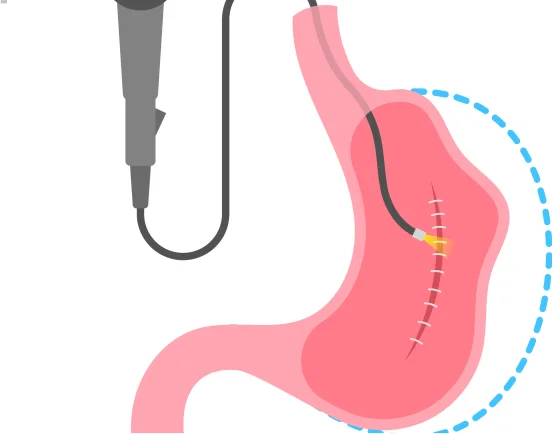Types of epigastric hernia repair surgery occurs when fat or tissue pushes through a weakness in the abdominal wall between the belly button and the breastbone (sternum). This type of hernia often presents as a small lump in the upper abdomen and may cause discomfort, especially when coughing, lifting heavy objects, or straining. While small, asymptomatic epigastric hernias can sometimes be observed over time, surgical repair is the only definitive treatment to prevent enlargement or complications such as incarceration or strangulation.
Fortunately, surgical repair of an epigastric hernia is highly effective and offers long-term relief. Thanks to advancements in medical technology, there are now several types of epigastric hernia repair surgeries available from the traditional open repair method to minimally invasive laparoscopic and robotic-assisted techniques. Each type of surgery has its own advantages, risks, recovery timelines, and cost considerations.
What Is Epigastric Hernia Repair Surgery?
Epigastric hernia repair surgery involves reinforcing or closing the defect in the abdominal wall to prevent internal tissues from pushing through. Depending on the size and complexity of the hernia, surgeons may opt for different surgical approaches, ranging from traditional open techniques to minimally invasive laparoscopic and robotic-assisted methods.
Goals of the Surgery :-
-
Relieve pain and discomfort
-
Prevent hernia enlargement or recurrence
-
Avoid potential complications such as bowel entrapment
Types of Epigastric Hernia Repair Surgery
The surgical method chosen depends on factors such as hernia size, patient health, previous surgeries, and surgeon preference. Here are the primary types of epigastric hernia repair:
Open Hernia Repair (Hernioplasty or Herniorrhaphy)
What it is :-
Open hernia repair is the traditional method where the surgeon makes a single incision directly over the hernia site.
Procedure :-
-
An incision is made over the hernia.
-
The herniated tissue is pushed back into the abdomen.
-
The defect is either stitched closed (herniorrhaphy) or reinforced with a synthetic mesh (hernioplasty).
-
The incision is closed with sutures or staples.
Advantages :-
-
Simple and effective for small hernias
-
Can be performed under local or general anesthesia
-
Short operating time
Disadvantages :-
-
Larger scar
-
Longer recovery time compared to minimally invasive methods
-
Slightly higher risk of infection or post-op pain
Laparoscopic Hernia Repair
What it is :-
A minimally invasive procedure involving small incisions and the use of a laparoscope (a thin tube with a camera).
Procedure :-
-
Several small incisions are made in the abdomen.
-
The laparoscope and surgical tools are inserted.
-
The surgeon views the inside of the abdomen on a video screen.
-
The hernia is repaired using mesh to reinforce the abdominal wall.
Advantages :-
-
Smaller incisions and minimal scarring
-
Faster recovery and return to normal activities
-
Lower risk of wound infections
-
Less postoperative pain
Disadvantages :-
-
Requires general anesthesia
-
More expensive than open surgery
-
Not ideal for very large or complicated hernias
Robotic-Assisted Hernia Repair
What it is :-
This is an advanced form of laparoscopic surgery where the surgeon uses robotic arms controlled via a console.
Procedure :-
-
Similar to laparoscopic surgery in terms of small incisions and mesh placement.
-
The robotic system offers high precision and better visualization.
Advantages :-
-
Enhanced precision and flexibility
-
Ideal for complex or recurrent hernias
-
Excellent cosmetic outcomes
-
Reduced pain and faster healing
Disadvantages :-
-
Higher cost
-
Availability limited to specialized centers
-
Longer operation time in some cases
Tension-Free Mesh Repair
Often part of both open and laparoscopic surgeries, tension-free mesh repair involves using a synthetic mesh to bridge and reinforce the hernia defect without pulling the surrounding tissue together.
Benefits of Tension-Free Technique :-
-
Lower recurrence rates
-
Less pain compared to traditional suture repair
-
Suitable for large hernias or patients with weak abdominal walls
Choosing the Right Surgery: Key Factors
Your surgeon will recommend the best type of epigastric hernia repair based on :-
-
Hernia size and location
-
Your age and overall health
-
Presence of other abdominal conditions
-
History of prior hernia repairs
-
Cost and insurance coverage
-
Recovery goals and lifestyle
For example, laparoscopic or robotic repair may be preferred for athletes or working professionals due to quicker recovery, while open surgery may be chosen for older patients with smaller hernias or limited access to advanced techniques.
Risks and Complications of Epigastric Hernia Surgery
Although hernia repair is a generally safe and common procedure, like all surgeries, it carries some risks :-
-
Infection or bleeding
-
Recurrence of the hernia
-
Seroma or fluid buildup
-
Nerve injury or chronic pain
-
Reactions to anesthesia
-
Bowel injury (rare)
These complications are rare, especially when the procedure is done by an experienced surgeon.
Recovery After Epigastric Hernia Repair
Hospital Stay :-
-
Most open surgeries are day-care or short-stay procedures.
-
Laparoscopic or robotic surgeries may also allow discharge within 24 hours.
Recovery Timeline :-
-
Pain and discomfort typically subside within a few days.
-
Light activities can be resumed within a week.
-
Strenuous exercise or lifting should be avoided for 4–6 weeks.
-
Complete healing may take 4 to 8 weeks, depending on the type of surgery.
Aftercare Tips :-
-
Follow all post-operative instructions from your surgeon
-
Keep the incision site clean and dry
-
Avoid smoking to speed up wound healing
-
Attend all follow-up appointments to monitor healing
Conclusion
Epigastric hernia repair surgery offers effective, long-term relief from symptoms and prevents future complications. With options ranging from traditional open repair to advanced robotic-assisted procedures, patients can choose a surgical method that best suits their needs and recovery goals.























